Levoit LV-H132 Review
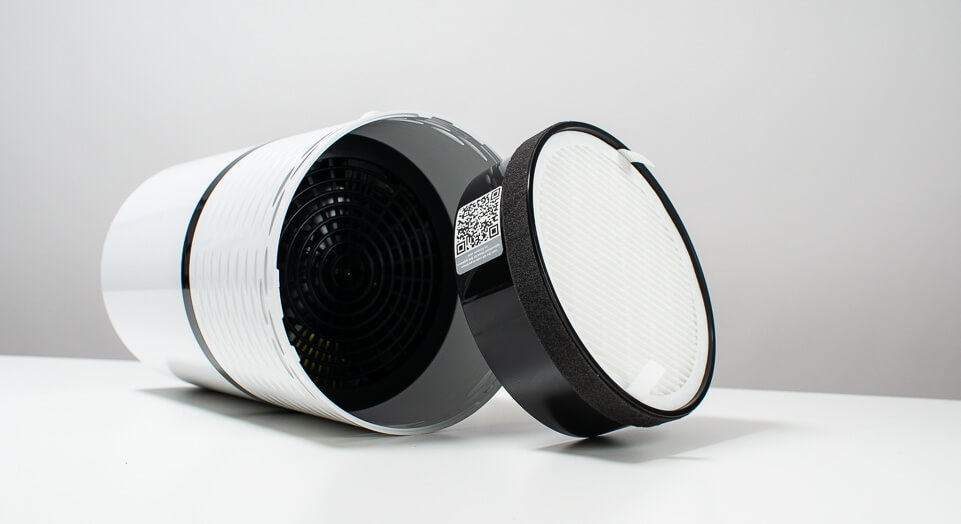
Feature Scores
Pros
- Good potential filtration – true HEPA filter, carbon filter with actual pellets for maximum surface area for adsorption of gases
- Small and light – highly portable
- All control panel lights can be turned off – for use in a dark room at night
Cons
- Poor value – at around $90 many other units on market that give you much greater output (CFM) and therefore greater area of coverage
- There’s nothing this unit does particularly well – average noise output, average energy efficiency compared to other units in its price range
Editor's Score
Quick Facts
| Particle filter type | HEPA |
|---|---|
| Gas filter type | Carbon (combined with HEPA) |
| Pre-Filter | Foam |
| Output | Well under 100 CFM |
| Air Movement | Foam pre-filter > HEPA filter side of combination filter > carbon filter side of combination filter |
| Number of fan speeds | 3 – low, medium, high |
| Size | 13 in. tall x 8 in. wide x 8 in. deep (cylinder with 8 in. diameter) |
| Weight | Just over 5 lb. |
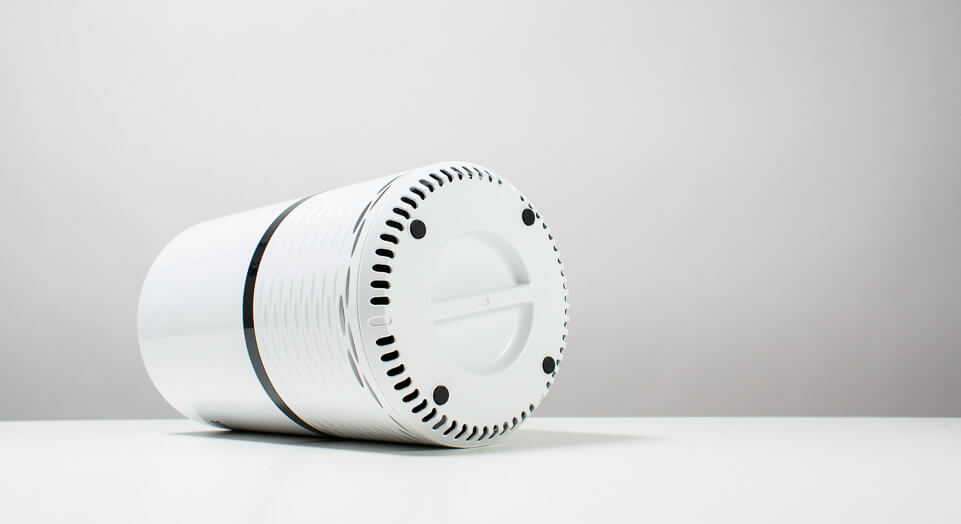




Analysis
A step by step breakdown of the LV-H132's performance.
Air Processing Performance
Test Results
In a 150 sq. ft. test environment the Levoit LV-H132 took 36 minutes to lower room particle concentration from 10,000 particles per cubic ft. down to 5,700 particles per cubic ft. This was the lowest room particle concentration it was able to achieve. Given an additional hour of run time it could not get room particle concentration any lower than 5,700 particles per cubic ft.
For comparison, the GermGuardian AC4825 lowered room particle concentration from 10,000 particles per cubic ft. down to 1,000 particles per cubic ft. in 23 minutes. Not only was the GermGuardian faster (23 minutes vs. 36 minutes for the Levoit) but it also lowered room particle concentration to a much lower threshold (1,000 particles per cubic ft. vs. 5,700 particles per cubic ft. for the Levoit).
Why the difference in performance? It’s mostly due to the difference in output between the two units. The Levoit has an estimated output of approx. 70 CFM. In other words, the Levoit can process only about 70 cubic ft. of air every minute. The GermGuardian has an estimated output of approx. 140 CFM. It can process up to 140 cubic ft. of air every minute. With approx. double the output, the GermGuardian AC4825 is able to lower room particle concentration much faster and achieve a much lower room particle concentration threshold than the Levoit.
Filter Analysis
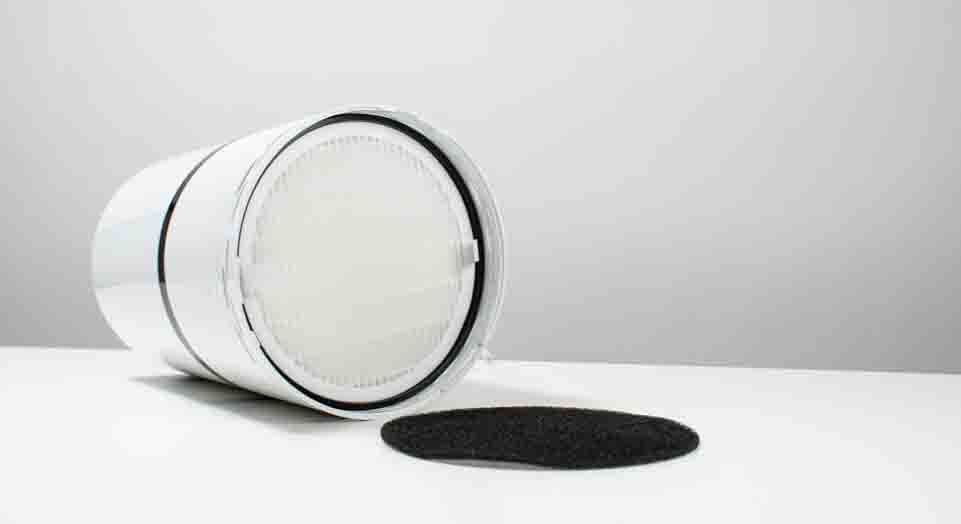
Particle Filter
The LV-H132, like the GermGuardian AC4825 and most other air purifiers on the market, is equipped with HEPA filter to remove particles like dust, smoke, and mold spores. Its HEPA filter is seated on one side of a single combination filter. The other side of the filter is a carbon filter. We’ll talk more about the carbon filter in the next section.
HEPA filtration is the standard for particle filtration in the air purifier industry. Everything from the approx. $90 LV-H132 to the approx. $900 IQAir HealthPro Plus is equipped with a HEPA filter.
HEPA is the industry standard because of its tremendous efficiency. A HEPA filter removes up to 99.97% of particles that travel through it. In other words, only 3 of every 10,000 particles that travel through a HEPA filter make it through to the other side. Those 3 particles are destined to get filtered on a second, third, fourth, etc. pass through the filter.
Other types of particle filters you may find on the market include HEPA Type filters and proprietary particle filters. HEPA Type filters usually have an efficiency rating above 90% but well under 99.97%. Proprietary particle filters range in efficiency from 90% all the way up to about 99%. The particle filters inside of Blue air purifiers are good examples here. The particle filter inside the Blue Pure 411, for example, is a proprietary particle filter with an efficiency of 99%.
All of this is to say that the LV-H132 comes equipped with a very good particle filter – a true HEPA filter. This unit has several shortcomings but its particle filter is not one of them.
Gas Filter
The LV-H132 is equipped with a carbon filter for the purpose of gas filtration – removing unwanted gases like odors and VOCs. The carbon filter is seated on the opposite side of the HEPA filter as part of a single combination filter.
This unit’s carbon filter contains actual carbon pellets – a unique feature for a unit in the price range. Most air purifiers at this price point, including the AC4825 have a carbon filter that is comprised of a fibrous material that is simply coated with carbon. The carbon filter on these units does not contain carbon pellets.
The presence of actual pellets provides superior gas filtration. Thus, the LV-H132’s carbon filter provides superior gas filtration to that of the AC4825 and other units like it.
The problem, again, is the unit’s output. Yes, it does have a superior gas filter, but only 70 cubic ft. of air is moving through that filter every minute. About double the amount of air – 140 cubic ft. of air – is moving through the AC4825’s carbon filter. So, while the LV-H132’s filter provides a theoretical advantage, in terms of gas filtration, in practice, its advantage is minimal.
If you’re looking for an affordable air purifier with good gas filtration our recommendation, instead of the LV-H132, would be the Winix 5500-2. The Winix is one of few air purifiers below $200 that comes equipped with a carbon filter with actual carbon pellets, like the Levoit. The difference is that the Winix has approx. 250 CFM of air processing power. So, unlike the Levoit, it has a good carbon filter AND sufficient output to make that carbon work well to remove unwanted gases in the average sized room.
Pre-filter
The LV-H132 comes equipped with a foam pre-filter. The pre-filter’s job is to remove larger particles before they reach the unit’s HEPA filter. The HEPA filter has to be replaced, at cost, when it saturates. The foam pre-filter can be vacuumed or rinsed. Thus, the pre-filter, by preventing larger particles from reaching the HEPA filter and saturating it, provides a cost savings over time as the HEPA filter doesn’t need to be replaced as often.
Most air purifiers in the price range do not come equipped with a separate pre-filter. The AC4825 and most other units at the same price point have a fibrous carbon filter that doubles as a pre-filter. The fibers in the carbon filter capture larger particles much like the foam of the LV-H132’s pre-filter captures larger particles. The difference here is that the Levoit’s pre-filter can be vacuumed or rinsed. The carbon filters in units like the AC4825 need to be replaced at cost when they saturate. Thus, the Levoit’s washable pre-filter provides a cost savings over units that don’t have a separate washable pre-filter.
Air Movement
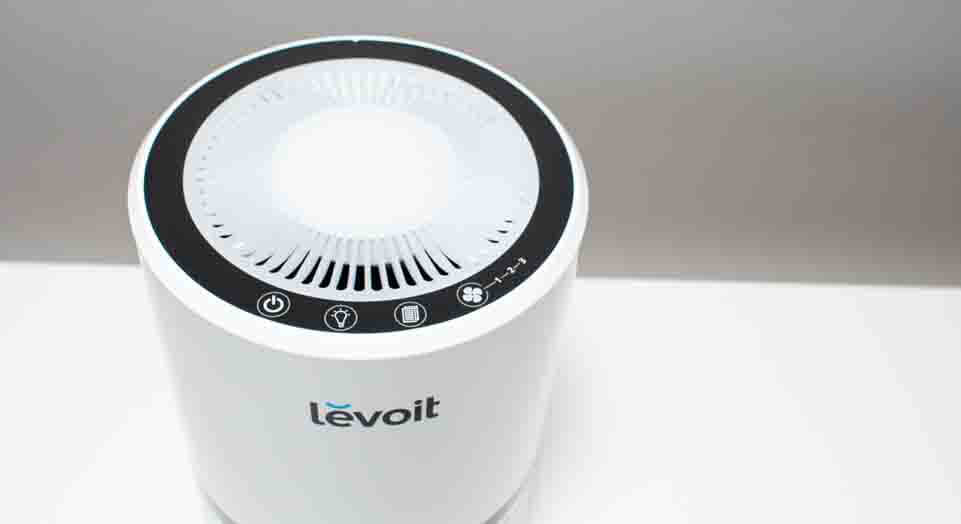
The Levoit LV-H132 outputs at approx. 70 CFM. This makes it viable in rooms up to 100 sq. ft. In rooms larger than 100 sq. ft. (like our 150 sq. ft. test environment) it will not clean the air in the room effectively. Recall that during our testing it was able to lower room particle concentration from 10,000 down to 5,800 particles per cubic ft. Most other units we tested, including the AC4825, achieved 1,000 particles per cubic ft. or lower.
Air with a particle concentration of 10,000 particles per cubic ft. is relatively dirty air and so is air with a concentration of 5,800 particles per cubic ft. The Levoit could not get room particle concentration lower than 5,800 particles per cubic ft. even after running on maximum fan speed for well over an hour of testing. Thus, the Levoit was not able to effectively clean the air in our 150 sq. ft. test environment.
Why? Because of its low output. Approx. 70 CFM is very low output. The GermGuardian AC4825, GermGuardian AC4300, Honeywell HPA100, and Blue Pure 411 are all in the same price range as the Levoit and all of them provide a total output above 100 CFM. These units can call be used in rooms up to 150 sq. ft. The Levoit cannot be used in rooms larger than 100 sq. ft.
Energy Efficiency
On maximum fan speed the Levoit draws 30.4 watts of power. At approx. 70 CFM this gives it a CFM/watt ratio of about 2.3. For comparison, the AC4825 draws 44.2 watts of power on max. fan speed at approx. 140 CFM for a CFM/watt ratio of 3.2. Thus, the GermGuardian has better energy efficiency on maximum settings (3.2 vs 2.3 CFM/watt ratio).
On its lowest fan speed the Levoit draws only 12.6 watts of power but CFM is heavily reduced. Still, the unit’s CFM/watt ratio on this setting improves to 2.8. The AC4825 draws 34.2 watts of power on its lowest fan speed, also with a substantial reduction in CFM. Its CFM/watt ratio worsens to 1.6. Thus, the Levoit has better energy efficiency on lower settings (2.8 vs 1.6 CFM/watt ratio).
Most smaller air purifiers give similar CFM/watt ratios – in the 2 to 3 CFM/watt range. Larger air purifiers often have much better energy efficiency, especially on lower fan speeds. The Winix 5500-2, for example, has a CFM/watt ratio of 4.6 on turbo (its highest fan speed) and a CFM/watt ratio of 12 on low (its lowest fan speed).
The bottom line: if you’re looking for an air purifier with maximum energy efficiency, most smaller units are about equally efficient while larger units are generally more efficient.
Noise Output
The LV-H132’s low output (approx. 70 CFM) makes it one of the quieter air purifiers we tested on high fan speed. On maximum fan speed it was measured at 60.7 dB of noise output. For comparison, most other air purifiers we tested were measured at 66 to 69 dB on high fan speed.
Again, its low output is the primary reason why it’s so quiet. The Levoit just doesn’t move a lot of air and since moving air is the primary noise maker in an air purifier, the Levoit isn’t very noisy.
Durability
The LV-H132 is reasonably well built for a unit at its price point. Comparing it side by side with other units in the same price range – units like the AC4825 or Honeywell HPA100 – no single unit has a distinct advantage in terms of build quality or the quality of the materials used for its construction.
What does distinguish these units is warranty length. Levoit and GermGuardian units only come with a 1 year warranty. Honeywell units come with a 5 year warranty.
Ease of Use
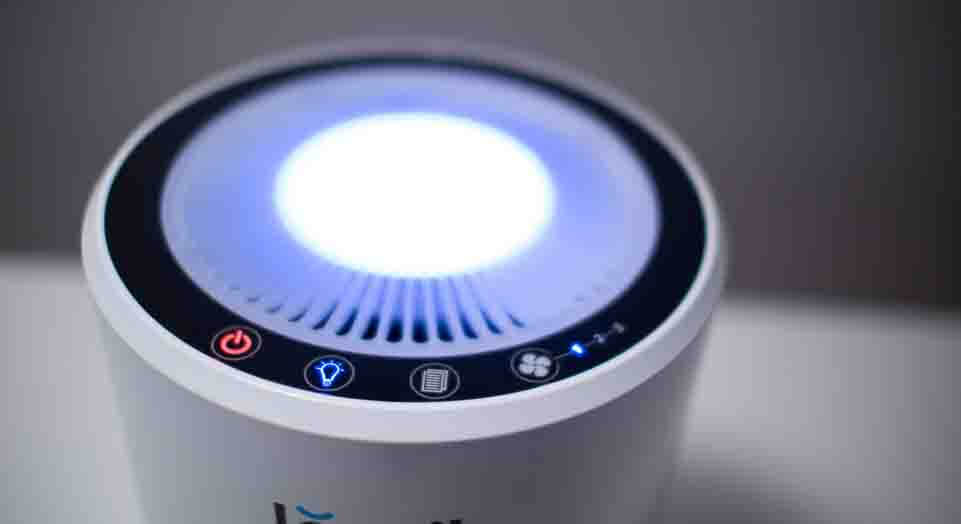
The LV-H132 has three different lights – a red power light, a blue fan speed light, and a top light. The first two lights (power and fan speed lights) can be turned off by long pressing the dimmer button on the unit’s control panel. The top light can be set to low, high, off by short pressing the dimmer switch. The first two lights show you the current status of the air purifier while the top light is more of a mood light.
Most other air purifiers on the market do not have mood lights and do not have control panel lights that can be turned off. The AC4825, for example, has a green power LED that always stays on with no way to turn it off. The Winix 5500-2 has several control panel LEDs that turn on when different modes are activated and an air quality sensor light – none of these lights can be dimmed or turned off without turning the actual air purifier off.
The LV-H132 is one of the smallest and lightest air purifiers we’ve tested. It’s essentially a 13 inch tall cylinder with an 8 inch diameter. It weighs just over 5 lb. For comparison, the AC4825, another relatively small air purifier, weighs just over 8 lb. but it’s 22 inches tall with a 10 x 7 inch base.
Note that even larger air purifiers are still relatively small and portable appliances. The Winix 5500-2, for example, weighs about 16 lb. and is under 2 ft. tall. It’s not as small and light as the Levoit but in some ways, you could say it’s even more portable because unlike the Levoit, it has a handle to pick it up by. The Levoit has no handle so you have to lift it up from the bottom when you pick it up to move it from one location to another.
Smaller, less expensive air purifiers like the Levoit LV-H132 and GermGuardian AC4825 lack the features of larger, more expensive units like the Winix 5500-2. The Levoit features 3 fan speeds and lighting control. The GermGuardian features 3 fan speeds. That’s it. The Winix 5500-2 and other units in the price range (approx. $150 to $200) usually feature an auto mode, a corresponding air quality sensor and air quality light on the control panel, optional ionization, a timer, and potentially a remote control. Again, cheaper units like the Levoit have none of these extra features.
Value
The LV-H132 usually retails for about $90, making it one of the more affordable air purifiers on the market. But is it a good value? We don’t think so.
The biggest reason why we think it’s a poor value: it’s low output.
The Levoit can only process about 70 cubic ft. of air per minute. This is about half the output of the GermGuardian AC4825. It’s about 40 less CFM than that of the Honeywell HPA100. It’s about 50 CFM less than that of the Blue Pure 411. All of these competitors can be bought at approx. the same price as the Levoit. And because of their much greater output and much larger area of coverage (because of their greater output) present a much better value than the Levoit.
If you’re looking for a small air purifier for a small room and have a smaller budget, our recommendation is the approx. $80 AC4825. It gives you approx. the same filtration quality, energy efficiency and noise output with double the air processing power of the Levoit.
If you’re able to increase your budget to approx. $150 our recommendation is a full size top rated unit like the Winix 5500-2. It gives you better filtration quality, better noise output and energy efficiency, and more than triple the air processing power of the Levoit.
Add a Comment
Have a question or comment? Let us know below.

Comments